There have been 2094 Test matches. I haven't seen them all, but I've known a few. Some of them were young delinquents, who went off the rails early on: Tests like the glassy-eyed psychopath
1396 or the shifty and unreliable 1907.
Others, such as
1617,
1508 and
1296 had a thrilling existence; they lived fast and died young. A few, like
302,
498,
905 and
1535 even achieved greatness.
But most Test matches are not that memorable. They start off with high hopes, experience a few life-affirming moments, then subside into dull middle age.
The Oval Test appeared to be going the same way. By the afternoon of the second day, it had joined the Young Conservatives, passed its accountancy exams, married, settled down in an obscure suburb, taken out a
Daily Telegraph subscription, and bought a set of golf clubs.
Then, without warning, on Sunday the Test had a mid-life crisis, and went on a reckless rampage. There was a car chase, a gunfight, and a desperate pursuit along the roof of a speeding train. By the evening it was engaged in a bitter life-and-death struggle with its arch enemy atop a runaway tank packed with dynamite just yards from the edge of the Grand Canyon, when the Test got a call. Apparently it was cocoa time. So the Test packed up, shook hands, caught a bus home, put on its slippers and settled down for its evening nap.
This free-form, random excitement that arrives out of nowhere and disappears just as quickly is one of the joys of Test cricket. In fact, it's the only joy of Test cricket. Weighing in on the debit side are the slow play, the silly etiquette, the belief that sportsmen can't play sport when it's a bit wet, or a bit gloomy, or a bit late, and the experience of sharing a ground for a week with thousands of drunks singing football songs and booing like disgruntled baboons.
The BBC reporter at The Oval, in trying to sum up the excitement of the final session, described it as being just like a one-day game. He was right. Time was running out, there was a target to get, a scattered field, a thrilled crowd. Admittedly it was a chaotic, unplanned one-day game, with no Duckworth-Lewis, and a generous attitude to wides, but it was unmistakeably a one-day game, at least until Test cricket's pettifogging rules ruined it.
But the three, four, and five day formats have always contained this precious entertainment gem, like a jewel hidden in a lump of old rock. Chisel away the crusty archaisms, the endurance contest, the time-wasting, and the hours of uneventful standing around, and you are left with the good bits: the daredevil fielding; the long, unwinding tension of a run chase, and the knowledge that the battle will be decided one way or the other.
One-day cricket, in other words.
So whilst it would be pleasant to preserve Test matches, the goings-on at The Oval are just the latest demonstration that we don't really need them. One-day cricket isn't an add-on to prop up the finances of the longer format. It is the essence of the thing; it is cricket polished, refined and made ready for the future.

